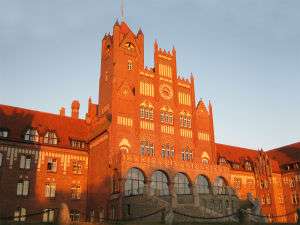Mürwik Naval School
The Mürwik Naval School (German: Marineschule Mürwik) is the main training establishment for all German Navy officers and replaced the German Imperial Naval Academy in Kiel.
 | |
| Location | Mürwik Flensburg , |
|---|---|
| Affiliations | German Navy |
It is located at Mürwik which is a part of Germany's northernmost city, Flensburg. Built on a small hill directly by the coast, it overlooks the Flensburg Fjord.
History
The Naval Academy was established at this site by the order of Kaiser Wilhelm II in 1910. Its unique gothic architecture with the dominating red bricks was meant to imitate the castle Ordensburg Marienburg, founded in 1274.[1] Architect of the Building was Adalbert Kelm.
In 1920 Sherwood Foresters were in Flensburg-Mürwik at the Naval Academy Mürwik to supervise the elections to the Schleswig plebiscites.[2][3]
In the final days of World War II, Grand Admiral Karl Dönitz assumed the office of President (Reichspräsident) of Germany. Adolf Hitler himself had named him his successor before committing suicide at Berlin. Dönitz moved to the Naval Academy at Mürwik. He established on the edge of it, in the sportschool the Flensburg government. Soon after the final surrender to the Allies, they were unseated and arrested by British troops. This made Flensburg capital of Germany for nearly 20 days. Today, the collection of the National Maritime Museum in Greenwich, London includes old ship models, old paintings and flags taken from the Naval Academy Mürwik by British troops after the War.
Education of German naval officers

As most naval officer cadets join the German Navy after passing their A-levels at school, signing up for thirteen years of service (can be extended to a "lifetime" of around 35 years), the standard education consists of three parts:
1) The basic education at the Naval Academy lasts at least one year.
2) It is usually followed (exceptions to be made) by university studies at the University of the German Federal Armed Forces which last around four years.
3) Given their degree of Bachelor or Master officers then return to the Naval Academy and other naval schools for advanced training. The advanced training lasts up to two years, depending on the officers' choice of an operational or engineering career and on the type of vessel, they are going to serve on. Those heading for a land-based post, also get the basic parts of the advanced training.
The Naval Academy at Muerwik carries out both, the basic education of officer cadets as well as parts of the advanced training for officers.

Basic education
The one-year lasting basic education of all German Navy cadets basically consists of four parts: Being new in the German Navy, all cadets first perform six weeks of collective basic training at Mürwik. After this they are divided in three groups which will consecutively take part in three sections of training: A sailing trip with German Navy's training ship Gorch Fock, a mission-preparing part at the "NCO's school" (Marineunteroffizierschule/MUS) in Plön and the officer's training again at Mürwik. Cadets who will serve at the German forces' medical service only take part in the first trip with Gorch Fock and the six weeks basic training.
Advanced training
Advanced training for officers provides further knowledge on various military topics, like leadership studies or military law. Depending on their choice of an engineering or operational career, officers will also join special courses like officer-of-the-watch training, specialised weapon systems training or naval engineering.
References
- Flensburger Tageblatt 100 Jahre Marineschule : Das rote Schloss des deutschen Kaisers
- ´Schleswig-Holsteinischer Zeitungsverlag: 100 Jahre Marineschule Mürwik – Geschichte der Schule, 11 August 2010]
- Dieter-Jürgen Mehlhorn: Architektur in Schleswig Holstein. Vom Mittelalter bis zur Gegenwart. Kiel/Hamburg 2016, Seite 140
External links
| Wikimedia Commons has media related to Marineschule Muerwik. |
- Marineschule Mürwik - Official German website